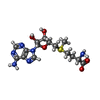[English] 日本語
 Yorodumi
Yorodumi- EMDB-30456: NSD3 bearing E1181K/T1232A dual mutation in complex with 187-bp N... -
+ Open data
Open data
- Basic information
Basic information
| Entry | Database: EMDB / ID: EMD-30456 | |||||||||||||||||||||
|---|---|---|---|---|---|---|---|---|---|---|---|---|---|---|---|---|---|---|---|---|---|---|
| Title | NSD3 bearing E1181K/T1232A dual mutation in complex with 187-bp NCP (2:1 binding mode) | |||||||||||||||||||||
 Map data Map data | ||||||||||||||||||||||
 Sample Sample |
| |||||||||||||||||||||
 Keywords Keywords | nucleosome complex / histone methyltransferase / DNA / Gene reguration / GENE REGULATION | |||||||||||||||||||||
| Function / homology |  Function and homology information Function and homology information[histone H3]-lysine4 N-dimethyltransferase / [histone H3]-lysine27 N-dimethyltransferase / histone H3K4 dimethyltransferase activity / histone H3K27 dimethyltransferase activity / histone H3K27 trimethyltransferase activity / histone H3K36 methyltransferase activity / transcription regulator activator activity / histone H3 methyltransferase activity / PKMTs methylate histone lysines / structural constituent of chromatin ...[histone H3]-lysine4 N-dimethyltransferase / [histone H3]-lysine27 N-dimethyltransferase / histone H3K4 dimethyltransferase activity / histone H3K27 dimethyltransferase activity / histone H3K27 trimethyltransferase activity / histone H3K36 methyltransferase activity / transcription regulator activator activity / histone H3 methyltransferase activity / PKMTs methylate histone lysines / structural constituent of chromatin / nucleosome / heterochromatin formation / nucleosome assembly / methylation / protein heterodimerization activity / regulation of DNA-templated transcription / chromatin / positive regulation of DNA-templated transcription / DNA binding / zinc ion binding / nucleoplasm / nucleus Similarity search - Function | |||||||||||||||||||||
| Biological species |  Homo sapiens (human) / Homo sapiens (human) / | |||||||||||||||||||||
| Method | single particle reconstruction / cryo EM / Resolution: 3.15 Å | |||||||||||||||||||||
 Authors Authors | Li W / Tian W | |||||||||||||||||||||
| Funding support |  China, China,  United States, 6 items United States, 6 items
| |||||||||||||||||||||
 Citation Citation |  Journal: Nature / Year: 2021 Journal: Nature / Year: 2021Title: Molecular basis of nucleosomal H3K36 methylation by NSD methyltransferases. Authors: Wanqiu Li / Wei Tian / Gang Yuan / Pujuan Deng / Deepanwita Sengupta / Zhongjun Cheng / Yinghua Cao / Jiahao Ren / Yan Qin / Yuqiao Zhou / Yulin Jia / Or Gozani / Dinshaw J Patel / Zhanxin Wang /   Abstract: Histone methyltransferases of the nuclear receptor-binding SET domain protein (NSD) family, including NSD1, NSD2 and NSD3, have crucial roles in chromatin regulation and are implicated in oncogenesis. ...Histone methyltransferases of the nuclear receptor-binding SET domain protein (NSD) family, including NSD1, NSD2 and NSD3, have crucial roles in chromatin regulation and are implicated in oncogenesis. NSD enzymes exhibit an autoinhibitory state that is relieved by binding to nucleosomes, enabling dimethylation of histone H3 at Lys36 (H3K36). However, the molecular basis that underlies this mechanism is largely unknown. Here we solve the cryo-electron microscopy structures of NSD2 and NSD3 bound to mononucleosomes. We find that binding of NSD2 and NSD3 to mononucleosomes causes DNA near the linker region to unwrap, which facilitates insertion of the catalytic core between the histone octamer and the unwrapped segment of DNA. A network of DNA- and histone-specific contacts between NSD2 or NSD3 and the nucleosome precisely defines the position of the enzyme on the nucleosome, explaining the specificity of methylation to H3K36. Intermolecular contacts between NSD proteins and nucleosomes are altered by several recurrent cancer-associated mutations in NSD2 and NSD3. NSDs that contain these mutations are catalytically hyperactive in vitro and in cells, and their ectopic expression promotes the proliferation of cancer cells and the growth of xenograft tumours. Together, our research provides molecular insights into the nucleosome-based recognition and histone-modification mechanisms of NSD2 and NSD3, which could lead to strategies for therapeutic targeting of proteins of the NSD family. | |||||||||||||||||||||
| History |
|
- Structure visualization
Structure visualization
| Movie |
 Movie viewer Movie viewer |
|---|---|
| Structure viewer | EM map:  SurfView SurfView Molmil Molmil Jmol/JSmol Jmol/JSmol |
| Supplemental images |
- Downloads & links
Downloads & links
-EMDB archive
| Map data |  emd_30456.map.gz emd_30456.map.gz | 36 MB |  EMDB map data format EMDB map data format | |
|---|---|---|---|---|
| Header (meta data) |  emd-30456-v30.xml emd-30456-v30.xml emd-30456.xml emd-30456.xml | 31.1 KB 31.1 KB | Display Display |  EMDB header EMDB header |
| Images |  emd_30456.png emd_30456.png | 91 KB | ||
| Filedesc metadata |  emd-30456.cif.gz emd-30456.cif.gz | 8.8 KB | ||
| Archive directory |  http://ftp.pdbj.org/pub/emdb/structures/EMD-30456 http://ftp.pdbj.org/pub/emdb/structures/EMD-30456 ftp://ftp.pdbj.org/pub/emdb/structures/EMD-30456 ftp://ftp.pdbj.org/pub/emdb/structures/EMD-30456 | HTTPS FTP |
-Validation report
| Summary document |  emd_30456_validation.pdf.gz emd_30456_validation.pdf.gz | 533.1 KB | Display |  EMDB validaton report EMDB validaton report |
|---|---|---|---|---|
| Full document |  emd_30456_full_validation.pdf.gz emd_30456_full_validation.pdf.gz | 532.6 KB | Display | |
| Data in XML |  emd_30456_validation.xml.gz emd_30456_validation.xml.gz | 5.8 KB | Display | |
| Data in CIF |  emd_30456_validation.cif.gz emd_30456_validation.cif.gz | 6.7 KB | Display | |
| Arichive directory |  https://ftp.pdbj.org/pub/emdb/validation_reports/EMD-30456 https://ftp.pdbj.org/pub/emdb/validation_reports/EMD-30456 ftp://ftp.pdbj.org/pub/emdb/validation_reports/EMD-30456 ftp://ftp.pdbj.org/pub/emdb/validation_reports/EMD-30456 | HTTPS FTP |
-Related structure data
| Related structure data |  7crqMC  7croC  7crpC  7crrC C: citing same article ( M: atomic model generated by this map |
|---|---|
| Similar structure data |
- Links
Links
| EMDB pages |  EMDB (EBI/PDBe) / EMDB (EBI/PDBe) /  EMDataResource EMDataResource |
|---|---|
| Related items in Molecule of the Month |
- Map
Map
| File |  Download / File: emd_30456.map.gz / Format: CCP4 / Size: 38.4 MB / Type: IMAGE STORED AS FLOATING POINT NUMBER (4 BYTES) Download / File: emd_30456.map.gz / Format: CCP4 / Size: 38.4 MB / Type: IMAGE STORED AS FLOATING POINT NUMBER (4 BYTES) | ||||||||||||||||||||||||||||||||||||||||||||||||||||||||||||||||||||
|---|---|---|---|---|---|---|---|---|---|---|---|---|---|---|---|---|---|---|---|---|---|---|---|---|---|---|---|---|---|---|---|---|---|---|---|---|---|---|---|---|---|---|---|---|---|---|---|---|---|---|---|---|---|---|---|---|---|---|---|---|---|---|---|---|---|---|---|---|---|
| Projections & slices | Image control
Images are generated by Spider. | ||||||||||||||||||||||||||||||||||||||||||||||||||||||||||||||||||||
| Voxel size | X=Y=Z: 1.08 Å | ||||||||||||||||||||||||||||||||||||||||||||||||||||||||||||||||||||
| Density |
| ||||||||||||||||||||||||||||||||||||||||||||||||||||||||||||||||||||
| Symmetry | Space group: 1 | ||||||||||||||||||||||||||||||||||||||||||||||||||||||||||||||||||||
| Details | EMDB XML:
CCP4 map header:
| ||||||||||||||||||||||||||||||||||||||||||||||||||||||||||||||||||||
-Supplemental data
- Sample components
Sample components
+Entire : NSD3 bearing E1181K/T1232A dual mutation in complex with 187-bp N...
+Supramolecule #1: NSD3 bearing E1181K/T1232A dual mutation in complex with 187-bp N...
+Supramolecule #2: Histone H3, H4, H2A, H2B
+Supramolecule #3: DNA
+Supramolecule #4: NSD3
+Macromolecule #1: Histone H3
+Macromolecule #2: Histone H4
+Macromolecule #3: Histone H2A
+Macromolecule #4: Histone H2B
+Macromolecule #7: Histone-lysine N-methyltransferase NSD3
+Macromolecule #5: DNA (168-MER)
+Macromolecule #6: DNA (168-MER)
+Macromolecule #8: S-ADENOSYLMETHIONINE
+Macromolecule #9: ZINC ION
-Experimental details
-Structure determination
| Method | cryo EM |
|---|---|
 Processing Processing | single particle reconstruction |
| Aggregation state | particle |
- Sample preparation
Sample preparation
| Concentration | 0.3 mg/mL |
|---|---|
| Buffer | pH: 7.5 |
| Vitrification | Cryogen name: ETHANE / Chamber humidity: 100 % / Chamber temperature: 281 K / Instrument: FEI VITROBOT MARK IV Details: blotted for 3 s before being plunged into liquid ethane. |
| Details | The sample was monodisperse. |
- Electron microscopy
Electron microscopy
| Microscope | FEI TITAN KRIOS |
|---|---|
| Specialist optics | Energy filter - Name: GIF Bioquantum / Energy filter - Slit width: 20 eV |
| Image recording | Film or detector model: GATAN K2 SUMMIT (4k x 4k) / Detector mode: SUPER-RESOLUTION / Average electron dose: 50.0 e/Å2 |
| Electron beam | Acceleration voltage: 300 kV / Electron source:  FIELD EMISSION GUN FIELD EMISSION GUN |
| Electron optics | C2 aperture diameter: 70.0 µm / Illumination mode: FLOOD BEAM / Imaging mode: BRIGHT FIELD / Cs: 2.7 mm |
| Sample stage | Specimen holder model: FEI TITAN KRIOS AUTOGRID HOLDER / Cooling holder cryogen: NITROGEN |
| Experimental equipment |  Model: Titan Krios / Image courtesy: FEI Company |
 Movie
Movie Controller
Controller


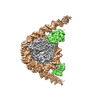




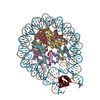
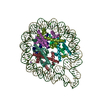
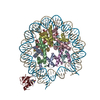

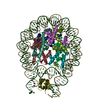





 Z (Sec.)
Z (Sec.) Y (Row.)
Y (Row.) X (Col.)
X (Col.)






















 Baculovirus transfer vector pFASTBAC1
Baculovirus transfer vector pFASTBAC1